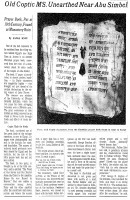A Coptic Apocryphal Manuscript from Nubia (the Qasr el-Wizz Codex)
Posted on October 4, 2012
When the High Dam was built in the 1960s, almost the entire Nile valley between Aswan and Wadi Halfa had been inundated in order to create the Lake Nassar. As the waters were rising, many archeological sites were destroyed, while others, such as the well-known temples of Abu-Simbel, were removed from their original location and re-erected elsewhere. During the construction of the dam, more precisely in October-November 1965, the archeological team from the Oriental Institute of the University of Chicago was excavating a Christian monastery at Qasr el-Wizz, situated just a couple of kilometers north of Faras, in Lower Nubia. I will not detail all the results of their excavations because good reports are available, for example, in G.T. Scanlon – G. Hingot, “Slip-Painted Pottery from Wizz,” African Arts 2 (1968) 8-13, 65-69 (article in English and French).Perhaps the most exciting discovery of the Chicago team at Qasr el-Wizz was a small parchment book written in Coptic. The manuscript was found almost intact, virtually the entire text being preserved. The Qasr el-Wizz codex was initially housed in the Coptic Museum in Cairo, but was later been moved to the new Nubian Museum in Aswan.
Via Charles Tiayon



 Your new post is loading...
Your new post is loading...







